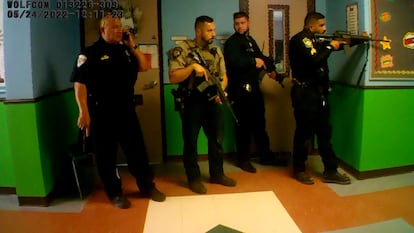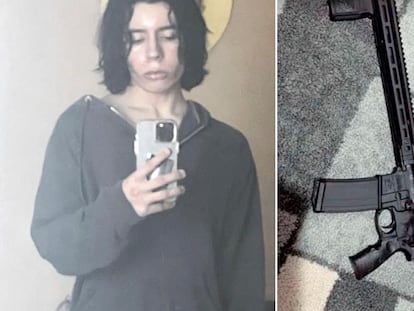Uvalde school board fires ‘coward’ police chief three months after massacre
Pete Arredondo was widely criticized for his response to the shooting that killed 19 children and two teachers, but his lawyer claims he is the victim of a ‘public lynching’


The Uvalde, Texas, school board voted unanimously on Wednesday to fire Pedro “Pete” Arredondo, the police chief widely criticized for his response to a shooting at a Texas elementary school that killed 19 children and two teachers. Arredondo did not attend the meeting, which coincided with the three-month anniversary of the tragedy, the second-worst school shooting in US history. Arredondo was put on unpaid administrative leave shortly after the May 24 shooting. His lawyer George Hyde, who requested that Arrendondo be reinstated, described the process as an “illegal and unconstitutional public lynching.”
Around 100 people turned out to see the school board dismiss Arredondo, who was considered a main figure in the police’s fumbled response to the shooting. As he entered the meeting, he was met by boos from relatives of the victims, who yelled at him, “coward” and “no justice no peace.” Family members of those killed in the massacre had repeatedly demanded that he be fired. The board meeting to discuss the dismissal, however, was carried out behind closed doors to the disappointment of the family members, who called for greater transparency.
According to an extensive report published by a Texas House committee, Arredondo was one of the first to arrive at the crime scene. Since 2020, he had overseen a six-member police force, which was tasked with monitoring nine schools within the county. Authorities in Uvalde created this police force following the May 2018 shooting at a school in Santa Fe, near Houston, which killed 10 people. The goal of the force was to prevent and respond to emergencies such as the one that happened at Robb Elementary School on May 24.
Arredondo led the official response to the shooting at Robb Elementary School, located in a small majority-Latino town in the southwestern part of the state, near the border with Mexico. In total, 376 officers were present that day.
But the actions of this police force left much to be desired. Salvador Ramos, the shooter, entered the school firing rounds from his AR-15. When the first police officers entered the school, Ramos fired at them, forcing them to retreat. This, according to the official investigation, led Arredondo to commit “a terrible, tragic mistake.”
Arredondo, who forgot his police radio and was issuing order via his cellphone, believed that Ramos was cornered in one of the classrooms. According to the Texas House committee report, as a result of this misconception, Arredondo began to think of the situation as one of a “barricaded subject,” instead of an active-shooter scenario. “We have this guy cornered. We have a group of officers on … the north side, a group of officers on the south side, and we have children now that we know in these other rooms. My thought was: We’re a barrier; get these kids out,” Arredondo testified to the Texas House committee. In an interview with The Texas Tribune, he said he never considered himself the scene’s incident commander.
Arredondo justified his actions, arguing that the officers did not hear any children screaming nor had a clear view of Ramos, who bought his arsenal of weapons the day he turned 18. “You have to have a target before you engage your firearm. That was just something that’s gone through my head a million times,” Arredondo added in his testimony.
Inside the classrooms, however, children and teachers were making emergency calls to 911, asking for police help. The officers were already at the scene, but no one did anything for 77 minutes, the time it took for a Border Patrol Tactical Unit to reach the school and fatally shoot Ramos.
But the 17-page statement from Arrendondo’s lawyer claims that the former police chief did no wrong. “When a government employer discharges an individual under circumstances that will do special harm to the individual’s reputation and fails to give that individual an opportunity to clear his name, the individual may recover monetary damages,” it stated. “The only person responsible for this tragedy is the shooter himself.”
“It’s a joke. Texas failed the students. Law enforcement failed the students,” said Vincent Salazar, grandfather of Layla Salazar, an 11-year-old victim of the massacre, on the day the report into the massacre was released.
Tu suscripción se está usando en otro dispositivo
¿Quieres añadir otro usuario a tu suscripción?
Si continúas leyendo en este dispositivo, no se podrá leer en el otro.
FlechaTu suscripción se está usando en otro dispositivo y solo puedes acceder a EL PAÍS desde un dispositivo a la vez.
Si quieres compartir tu cuenta, cambia tu suscripción a la modalidad Premium, así podrás añadir otro usuario. Cada uno accederá con su propia cuenta de email, lo que os permitirá personalizar vuestra experiencia en EL PAÍS.
¿Tienes una suscripción de empresa? Accede aquí para contratar más cuentas.
En el caso de no saber quién está usando tu cuenta, te recomendamos cambiar tu contraseña aquí.
Si decides continuar compartiendo tu cuenta, este mensaje se mostrará en tu dispositivo y en el de la otra persona que está usando tu cuenta de forma indefinida, afectando a tu experiencia de lectura. Puedes consultar aquí los términos y condiciones de la suscripción digital.
More information
Archived In
Últimas noticias
Most viewed
- Alain Aspect, Nobel laureate in physics: ‘Einstein was so smart that he would have had to recognize quantum entanglement’
- Alvin Hellerstein, a 92-year-old judge appointed by Bill Clinton, to preside over Maduro’s trial in New York
- Gilles Lipovetsky: ‘If you want to live better and fall in love, take Prozac, don’t look to philosophy’
- Cuba confirms death of 32 of its citizens in the US attack against Venezuela
- Why oil has been at the center of Venezuela-US conflicts for decades










































